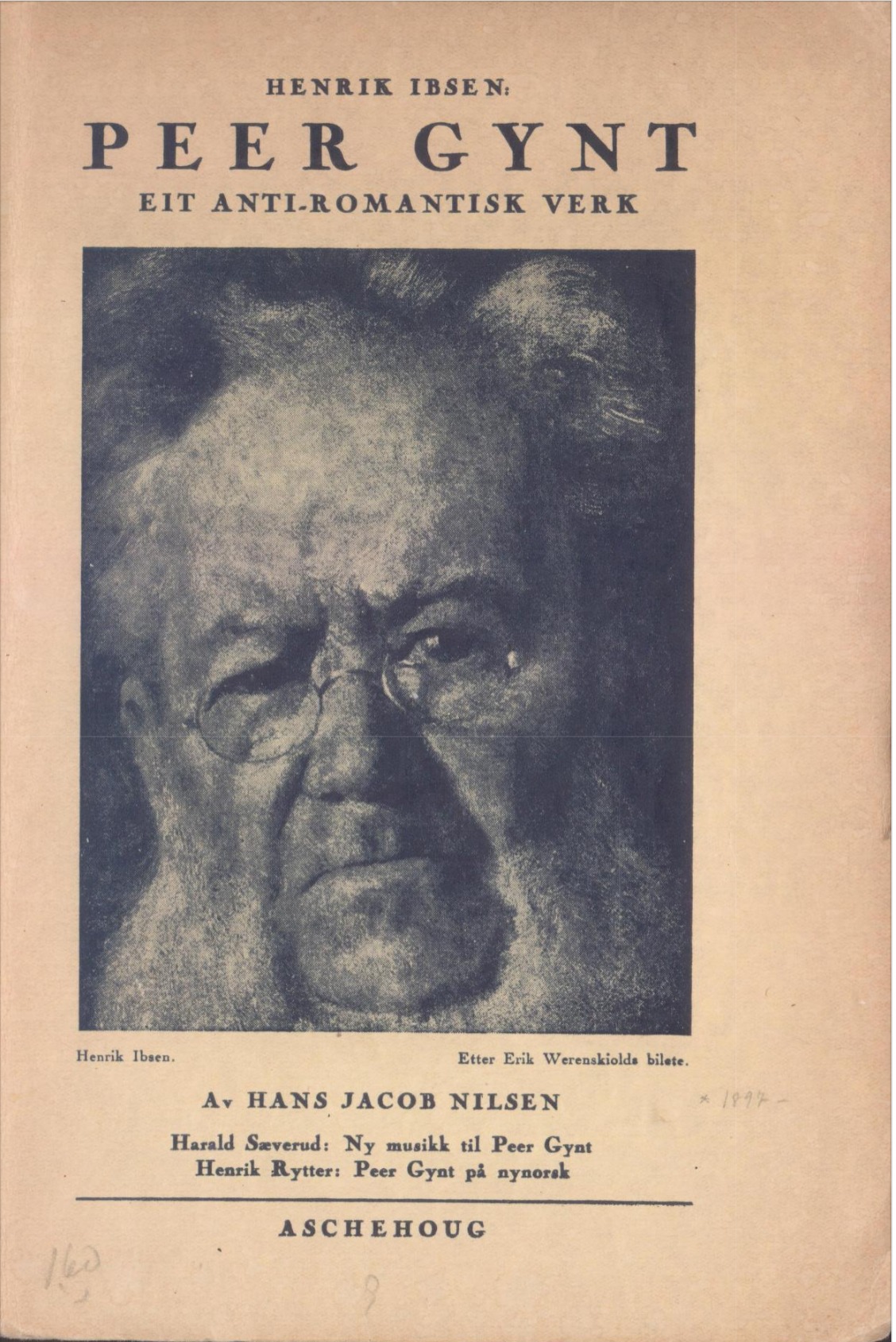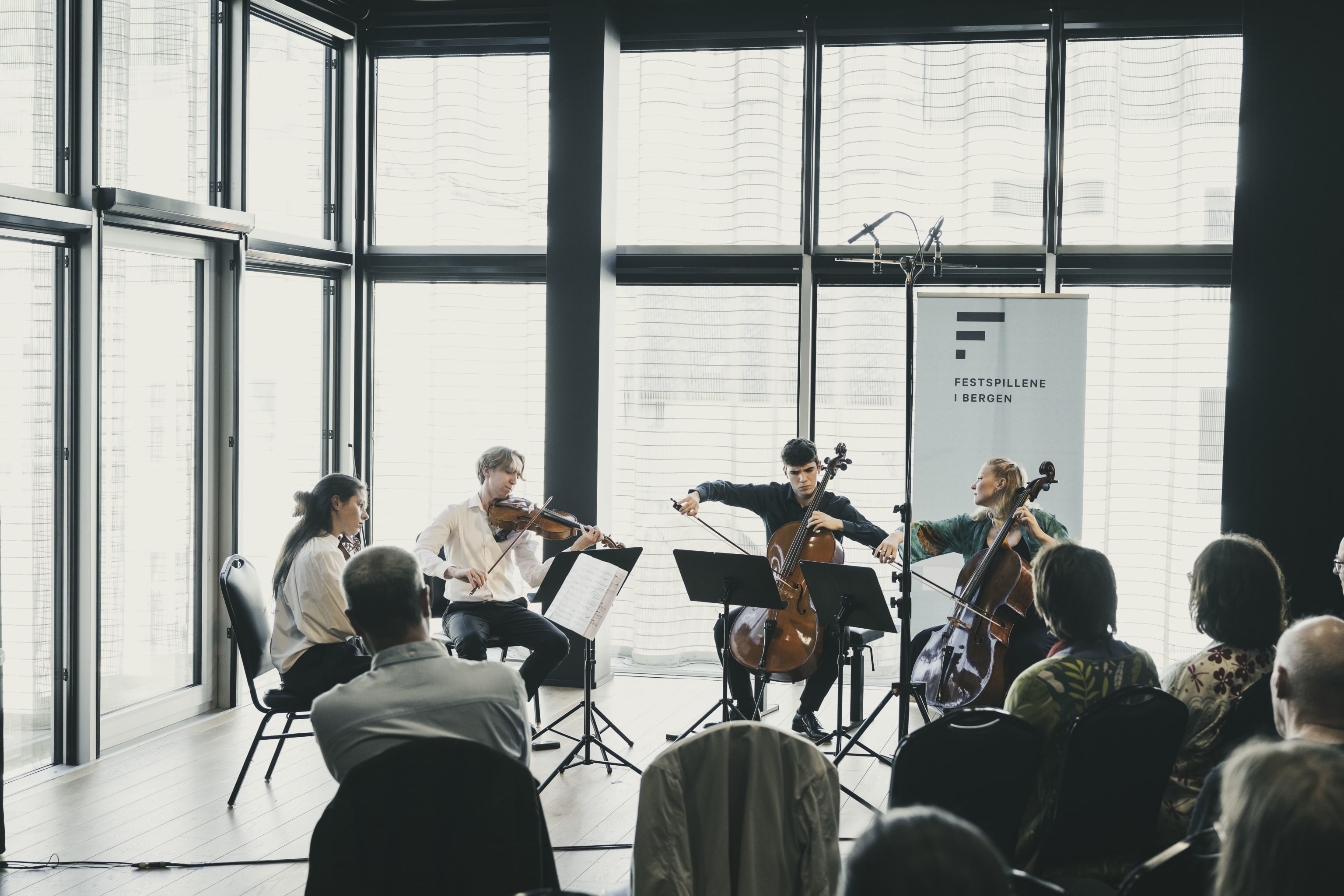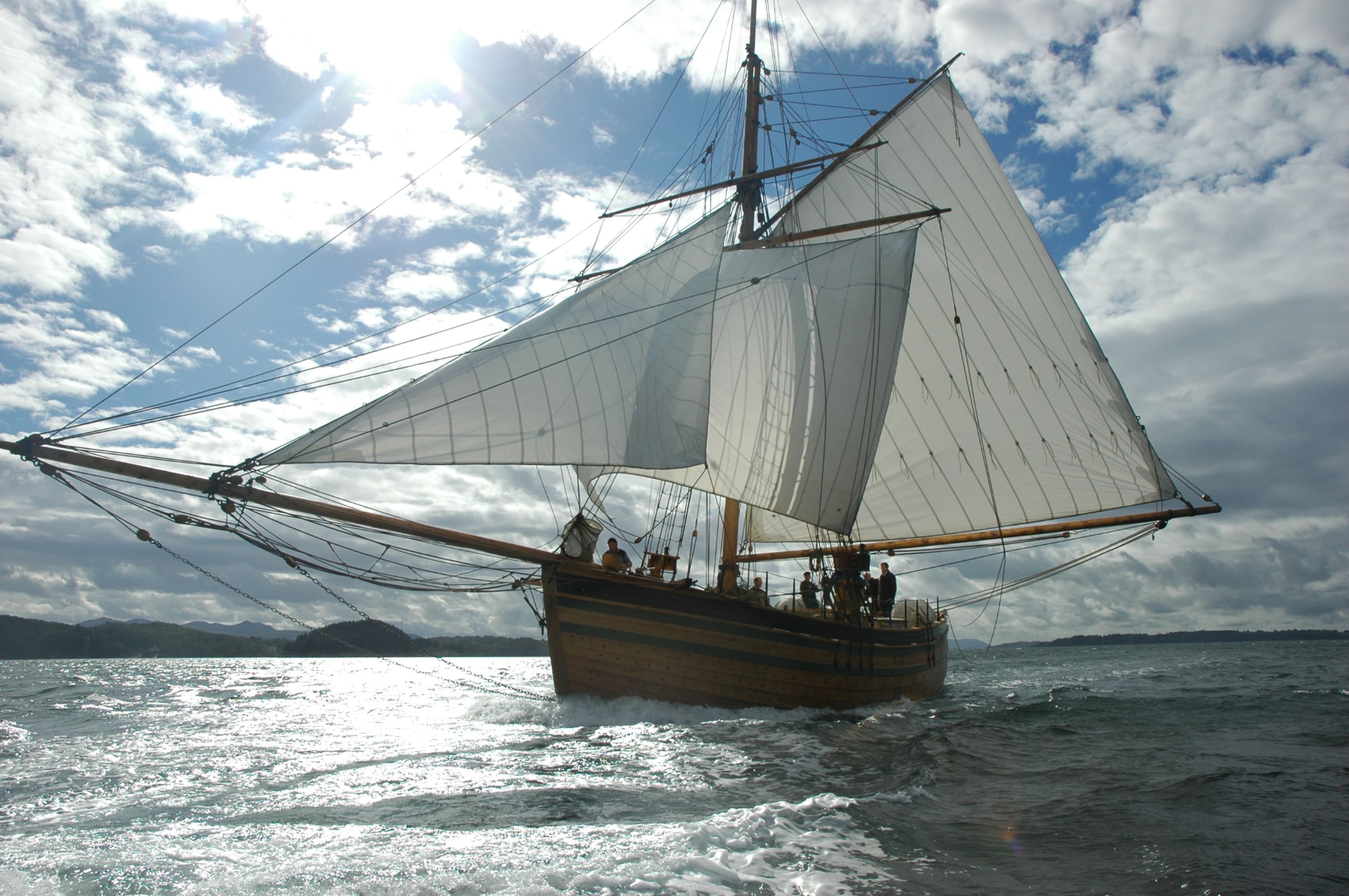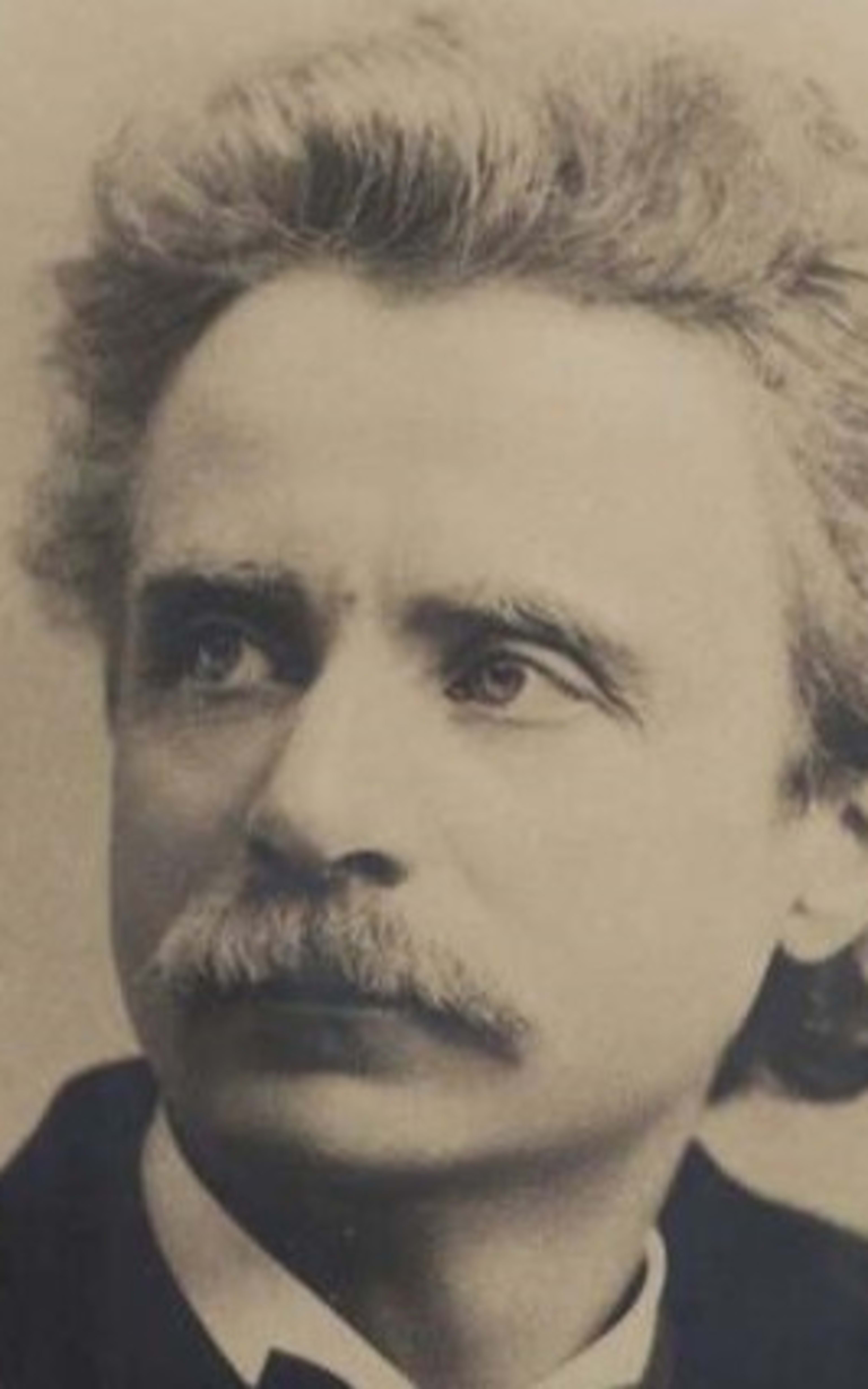
Grieg's Gynt
"Dear Mr. Grieg!" The 23 January 2024 marks 150 years since Henrik Ibsen wrote his letter to Edvard Grieg asking if Grieg would compose "the necessary music" for the dramatic poem Peer Gynt.
When Peer Gynt is performed at the 2024 Bergen International Festival, you will have a rare opportunity to experience the result of this request: Edvard Grieg's music, together with the iconic work by Henrik Ibsen.
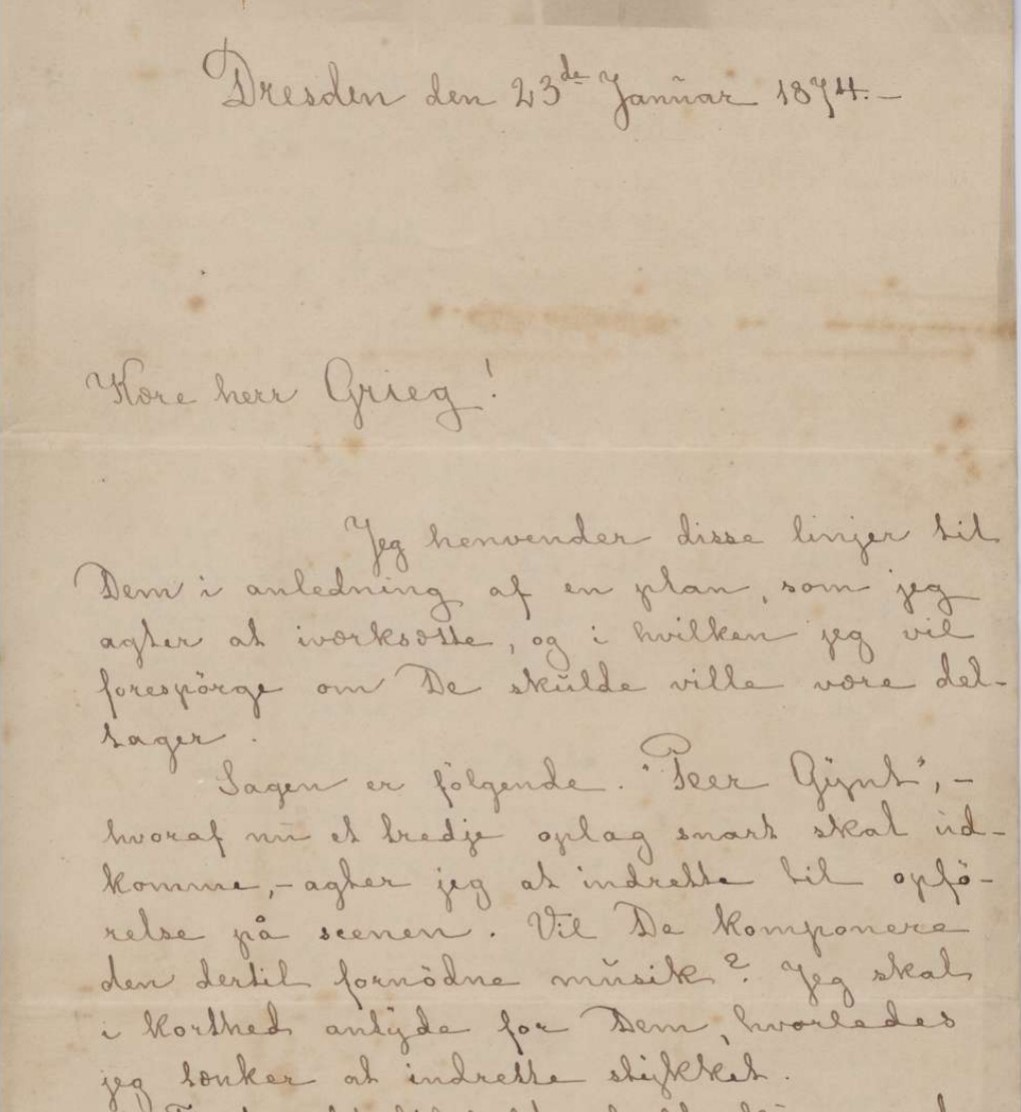 Read the letter in Grieg collection (in Norwegian)
Read the letter in Grieg collection (in Norwegian)
With an alluring sum of 400 spesidaler (around NOK 105 000 in today’s money) divided equally between Ibsen and Grieg, the composer said yes.
In his following letter a couple of weeks later, Ibsen was very much satisfied that Grieg was on board, writing: "How much music, and for which scenes you wish to compose, is of course entirely up to you; for a composer must have utterly unrestrained hands."
A year and a half later, the music for Peer Gynt was ready. Grieg had composed an incredible total of 26 pieces for Ibsen's five acts.
A symbol of Norwegian theatre
‘At this time, Ibsen was becoming popular abroad, and when Christiania Theater with great success staged Peer Gynt in 1876, it was probably the first time that foreign audiences started to notice Norwegian theatre, says Keld Hyldig, professor of theatre research at the University of Bergen.
In his book Ibsen og norsk teater (Ibsen and Norwegian theatre), Hyldig emphasises how Peer Gynt became an international symbol of Norwegian theatre. Together with Grieg's music, the entire play also became an important export item.
 Actors Henrik Klausen and Sofie Parelius in Peer Gynt by Henrik Ibsen. From the world premiere at Christiania Theater in 1876 - Norsk Teknisk Museum / DigitaltMuseum
Actors Henrik Klausen and Sofie Parelius in Peer Gynt by Henrik Ibsen. From the world premiere at Christiania Theater in 1876 - Norsk Teknisk Museum / DigitaltMuseum
A story about the most Norwegian of Norwegians, written in Italy
Early in his life, Henrik Ibsen struggled with debt. After increasing financial difficulties at Christiania Norske Theater, where Ibsen was artistic director and sometimes had to cover the actors' salaries himself, he fled to Italy. Here, aged 39, he wrote Peer Gynt in 1867.
Among the inspirational sources for his poem was a book called Norske Huldre-Eventyr og Folkesagn (Norwegian Hulder Fairy Tales and Folklore) by Peter Christian Asbjørnsen, which he was able to borrow from the library at The Scandinavian Association in Rome. Also, Ibsen was inspired by a journey he took through Gudbrandsdalen a few years earlier.
Browse Peer Gynt from Norwegian Folk and Hulder Fairy Tales (in Norwegian)
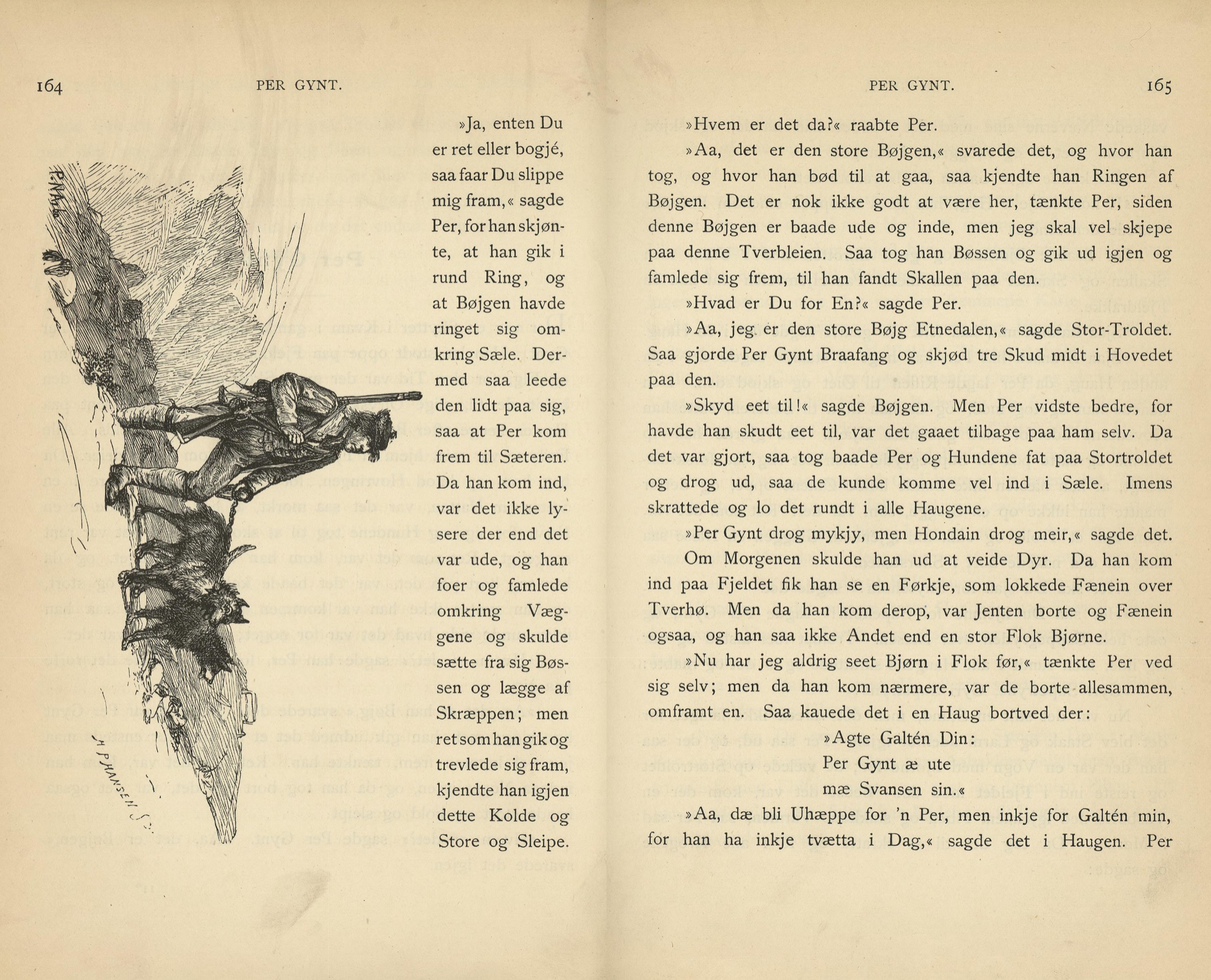
Interpreting Norwegian through borrowing, stealing, and retelling
'This text is about twisting what already exists; it’s about interpretation and staging', says Hedda Høgåsen-Hallesby, dramaturge at the Norwegian Opera & Ballet in Oslo.
In 2013, she earned a doctorate in musicology from the University of Oslo. Among other things, she has since studied the music, text and identity constructions in Grieg's and Ibsen’s musical version of Peer Gynt. She says that both Ibsen and Grieg borrowed and interpreted from other contemporary creators when building and staging the story of Peer.
'Ibsen was clearly influenced by existentially themed written dramas such as Goethe's Faust, satirical fantasy novels such as Swift's Gulliver's Travels and Holberg's The Journey of Niels Klim to the World Underground. Dovregubben (The Mountain King) is taken from H.C. Andersen's Elverhøj, and Botten-Hansen's Midsummer Fairy Tales both have stories about "Bøigen" and "Peder Jynt". Asbjørnsen's Reindeer Hunt by the Ronderne Mountains tells the story of Gudbrand Glesnes's wild ride. In this way, Ibsen borrowed and retold what already existed.'
Grieg also helped himself to material gathered from varied sources.
'Grieg borrowed and rewrote music from many sources of inspiration. He borrowed from Norwegian folk music in the form of melodies and rhythms but also borrowed from romantic performing arts music,' says Høgåsen-Hallesby.
Ibsen's only musical work
'It was probably the theatre that commissioned music for Gynt, with Ibsen as an intermediary,' says Hyldig.
Ibsen did not know Grieg – who was 15 years younger – particularly well, but the playwright supported the composer from Bergen and believed he had the artistic and human maturity for the task.
The writer had previously written a poem to Grieg, in which he urged him to play so that sparks fly from the stone; Play so that the Shapeshifter bursts!
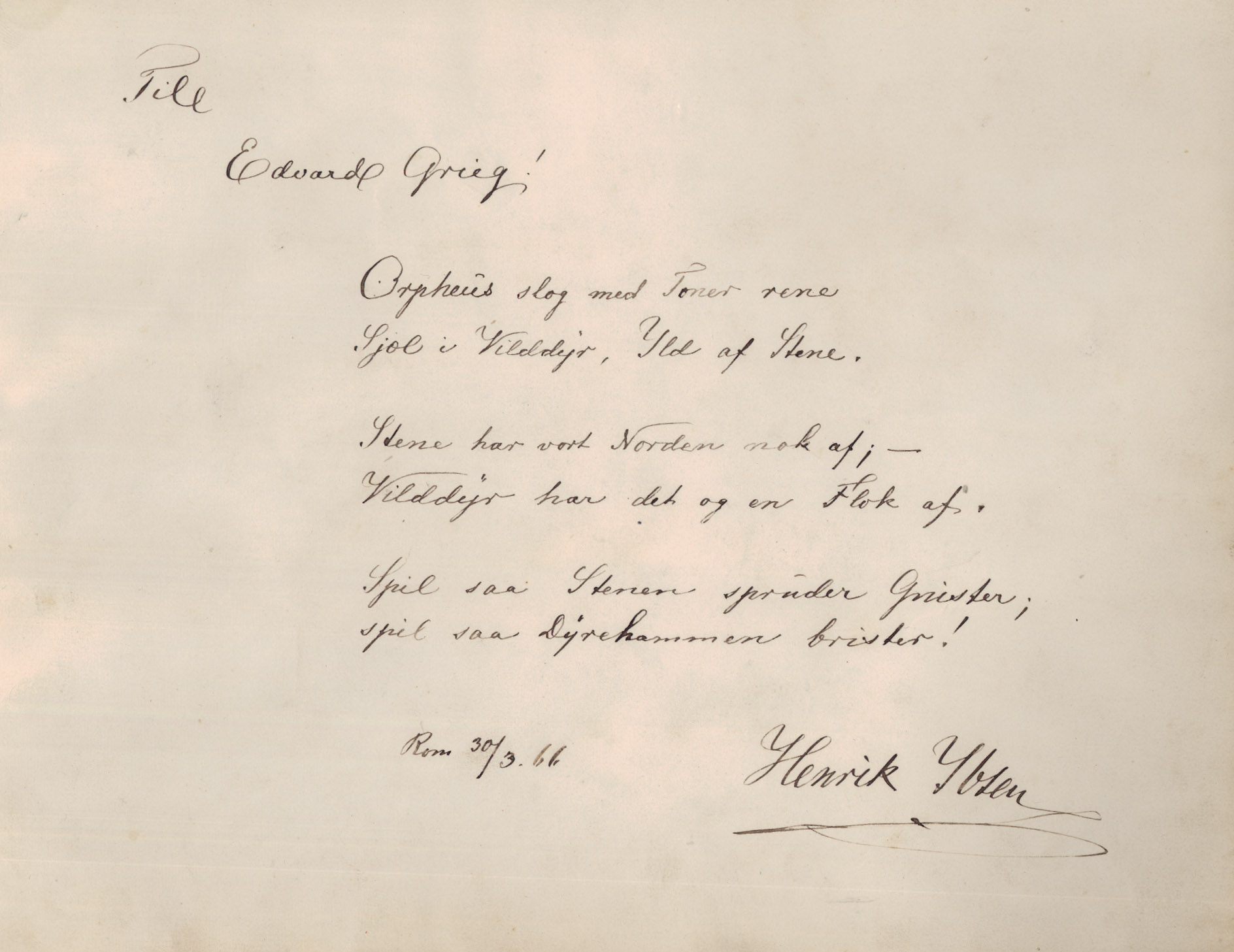 See more of Ibsen's letters to Grieg under "G" here.
See more of Ibsen's letters to Grieg under "G" here.
Apart from Peer Gynt, few of Ibsen's other works have been set to music.
'In 1859, Ibsen wrote a draft for a libretto for an opera called Fjeldfuglen (The Mountain Bird), but this was never completed. Ibsen's subsequent realistic contemporary dramas, such as A Doll's House and The Wild Duck, did not appeal as much to music,' says Hyldig.
A giant international success
'The premiere at Christiania Theater was a huge success. For the first time, the international press looked to Norway for theatre, and several productions were sold out,' says Monica Jangaard, music curator at Kode.
From the day after the world premiere, Morgenbladet was able to report on sold-out performances despite increased ticket prices and an impressed critic wrote: "One was full of expectations, and it is safe to say that the expectations of most who were present were exceeded."
A difficult time for Grieg
Despite the enormous success, neither Ibsen nor Grieg were present at the world premiere.
'It was a busy time for Grieg. Both his parents died within a short period around the time of the premiere, and he was not able to see the performance until November. The premiere was in February,' says Jangaard.
When Grieg finally saw the play, he did not think the orchestra played well enough, nor had he had the opportunity to influence the music during rehearsals. But when the performance was staged in 1886 at Dagmar Teatret in Copenhagen, Grieg was very involved and got the music the way he wanted it.
'Georg Brandes then wrote a review in Politiken where he thought Grieg's satire was evident in the music,' says Jangaard.
The satire in Gynt
Critics have since believed that Grieg's lavish, romantic music muffled the satire and irony in Ibsen's play. The contours of the irony did not emerge through the beautiful melodies, and besides, it was Norwegian propaganda when performed abroad.
'There was actually a lot of parodying of Norwegian peasant life in the play, which through Grieg's music and stage decorations became subject to national romanticism,' says Hyldig.
Regardless of what connoisseurs and others may think of whether the music suited the text, or what they think of Ibsen as a national romanticist, perhaps other considerations weighed heavier in the dramatist's choice of Grieg as composer.
'Ibsen was very attentive towards economic aspects. He always published the play in book form and usually had books for sale before the premieres, and therefore profited from both the book market and the theatre market. Perhaps he thought that Peer Gynt with Grieg's music could become a new, huge box office success,' says Hyldig.
Grieg himself wrote to his friend Frans Beyer that he composed with irony:
"With Peer Gynt, things are progressing very slowly, and finishing by Autumn is out of the question. It is a terribly unruly subject, certain places excluded, such as, e.g. where Solveig sings; I have completed all of that, too. And, also, I have made something for In the Hall of the Mountain King, which I literally cannot bear to listen to; that's how much it sounds of cow pats, of Norwegian-Norwegian-ness and self-satisfaction! But I also expect the irony to be felt."
'There are elements in Grieg's music that can be heard as a reflection of Ibsen's irony. The exaggeration and pomposity in, for example, In the Hall of the Mountain King can be seen as a musical parallel to Ibsen's exaggerated and satirical portrayal of certain aspects of Norwegian society and Peer Gynt's own grandiose illusions,' says Høgåsen-Hallesby.
More Peer
Many years later, Harald Sæverud was tasked with re-writing the music created for Peer Gynt, as performed in Hans Jacob Nilsen's New Norwegian (nynorsk) staging of the play in 1947.
Hans Jacob Nilsen from Det Norske Teatret in Oslo believed that Grieg's romantic and lyrical direction did not bring forth Ibsen's satire in the play. He had Henrik Rytter translate the play into nynorsk and Sæverud compose the new music.
The translation and the new music caused a great fuss. In connection with the production at Det Norske Teatret on 2 March 1948, Rytter printed the booklet Peer Gynt, eit anti-romantisk verk (Peer Gynt, an anti-romantic work).
‘Well, this must be the most thankless task of all, said Harald Sæverud upon receiving it.
The renowned composer believed that writing new music for Peer Gynt after Grieg was equivalent to chopping one's own head off, and he pointed out that Grieg's music was to be considered public property.
Sæverud initially refused, but the next morning, he said that his subconscious had been thinking for him and decided that he must do this. In addition, Sæverud had been reading Asbjørnsen's Per Gynt to his sons when the request from Hans Jacob Nilsen arrived in the mail.
See the interview with Sæverud below.
Listen to Sæverud's version of Solveig's song below.
Another musical version of Peer Gynt was composed by Arne Nordheim, one of the pioneers of Norwegian electronic music. Using tape recorders and synthesised sounds, Nordheim created a more experimental sonic approach to the play.
See interview with Arne Nordheim below.
Peer Gynt, with music by Arne Nordheim, was performed in October 1969 at Den Nationale Scene in Bergen.
See Nordheim's interpretation of Den grønnkledde (The Woman in Green).
Back to Grieg
'Grieg's setting of music to Ibsen's text still holds the position as the most famous Norwegian stage music, especially the pieces In the Hall of the Mountain King, Morning Mood, Anitra's Dance and Death of Åse. These pieces have melodies that stick easily in the mind and have dramatic development that builds steadily and pulls us into a story that exists even beyond the context of the stage and ranges widely from the light and playful to the deep and melancholic,' says Høgåsen-Hallesby.
Although Grieg's music for Peer Gynt became world famous, many new productions of the play do not include his music.
In 2005, the Bergen International Festival staged Peer Gynt together with star director Robert Wilson. The text was translated by Jon Fosse, and the music was improvised on stage by violinist Michael Galasso, leaving Grieg out entirely. The following year, the festival showed director Calixto Bieito's version in Catalan, also without Grieg.
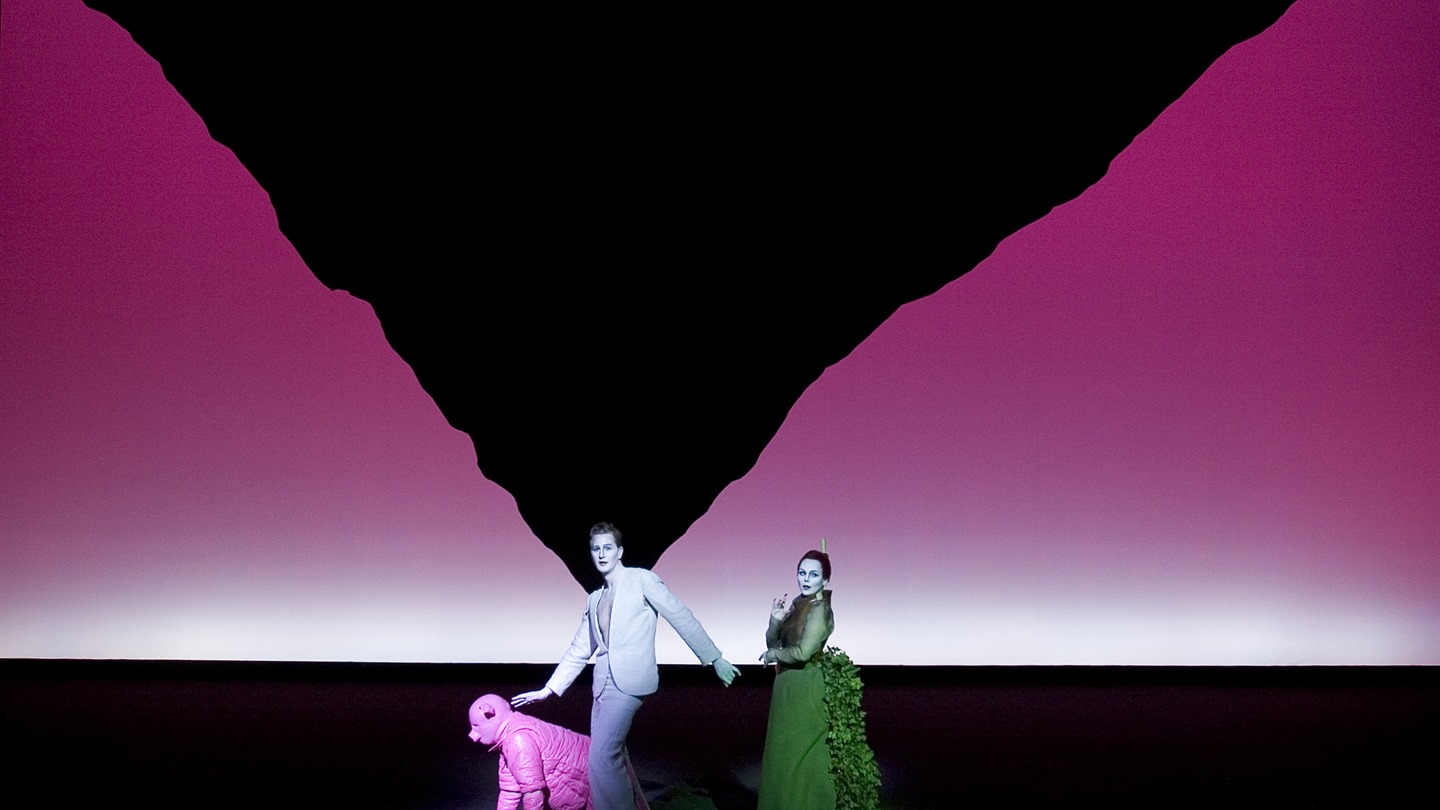 Robert Wilson's "Peer Gynt" from the 2005 Bergen International Festival. Photo: DNS/Lesley Leslie-Spinks
Robert Wilson's "Peer Gynt" from the 2005 Bergen International Festival. Photo: DNS/Lesley Leslie-Spinks
However, in 1993, during the 150th anniversary of Edvard Grieg, Kjell Bang-Hansen staged Peer Gynt on Den Nationale Scene. The production was initially created without Grieg's music for the Hålågoland Teater in 1978. When he decided to stage it again in 1993, the following was written in the festival programme:
Here, two world-renowned names meet: on the one hand, Ibsen, with his dark moral-philosophical and critical fundamental tone, and on the other, Grieg, with his national vision and romantic temperament. Through «Peer Gynt», the two have become inextricably linked, and to some extent, both must also be said to be indebted to each other for the fame of their respective works.
This is the paradox that Kjetil Bang-Hansen wants the basis of his production to be, through what perhaps can be called a contrapuntal rather than accompanying interplay between music and text.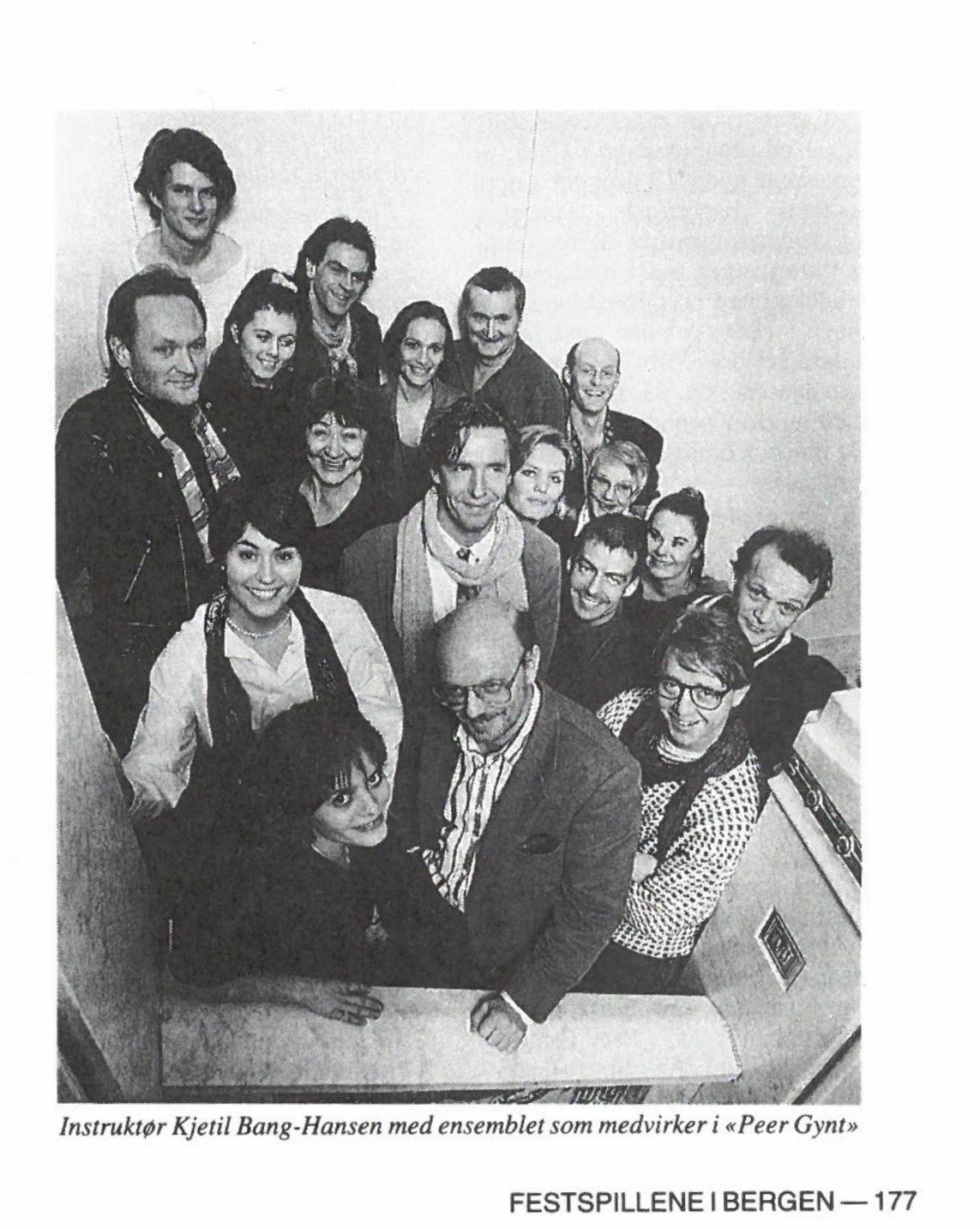 Picture from the 1993 Bergen International Festival catalogue.
Picture from the 1993 Bergen International Festival catalogue.
The production was a great success, and many will remember Sissel Kyrkjebø in the role of Solveig.
"... the musical intentions only become clear during a stage performance"
'There is almost an operatic format to the play; it requires many musicians and a good soprano. I have not often seen Peer Gynt performed as a whole on stage,' says Jangaard.
'Ibsen's long and complex play together with Grieg's complete musical score makes the production both resource- and time-consuming, as well as challenging to perform,' says Høgåsen-Hallesby, and continues:
'The combination of Grieg and Ibsen's Peer Gynt is a kind of hybrid genre. It is not an opera, nor is it a musical. It is like stage text with music that there is sometimes a lot of and, for longer periods, little of.
Grieg himself emphasized the importance of experiencing the music of Peer Gynt in its rightful surroundings. He wrote to Finck on 30 July 1905: "If you had the opportunity to witness a performance, you would discover that the musical intentions only become clear during a stage performance."
A rare thing
One hundred fifty years after Ibsen sent his letter to Grieg, the play – both with and without Grieg's music – has had a long, global life. When it is performed with Grieg's music during the 2024 Bergen International Festival, it is, therefore, a rare thing to witness, but one that has stood the test of time throughout a century of praise and criticism.
'Next to A-ha's Take On Me and Kygo's songs, Edvard Grieg's Peer Gynt is probably the music made by a Norwegian composer that is played the most internationally and which has achieved a timeless status in the world's musical heritage,' says Høgåsen-Hallesby.
'The story of Peer Gynt continues on and on and on, just as the Bøyg concludes it all in Ibsen's work: "See you at the next crossroads, Peer, and then we'll see, I'll say no more".




